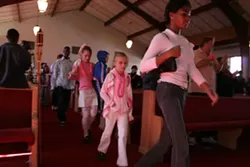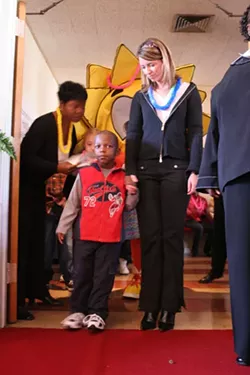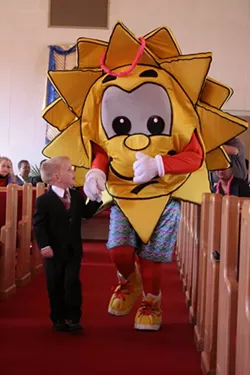Too many children in Mecklenburg County have no permanent family.
So adoption recruiters have taken to putting kids on the catwalk.
The man in the pew behind me at the Briar Creek Baptist Church is clapping so loudly my ears hurt. But we aren't here to witness an especially rousing sermon. We're partway through a fashion show featuring foster kids up for adoption. Aaron, a ninth-grader at Independence High School, is hamming it up. Wearing a gray, flannel Old Navy sweatshirt, he does a cartwheel up the aisle of the east Charlotte sanctuary.
"Lots of energy," says Amy Ciceron, an adoption recruiter for the Mecklenburg County Department of Social Services. She's narrating the event from a podium at the side of the stage, encouraging the kids as they stand before an audience ready to impress.
Upon reaching the altar, Aaron's up on his heels and sparring in the air like a latter-day Muhammad Ali. "Put that in a bottle and sell it," Ciceron says.
Outside, it's a beautiful, cloudless autumn day, perfect for playing catch with Dad or having a family picnic. But these kids are anxiously awaiting their turn to perform, and hoping to meet their future parents. The audience -- racially mixed, with the majority being black and female -- watches as the children, ages 4 to 17, step through a pair of double doors at the right side of the sanctuary. Ciceron estimates that slightly more than half of the attendees are already foster parents; others are folks interested in adopting. All are urged to wear plastic leis with tags bearing the day's theme: "It's Hot to Adopt!"
The kids, with dozens of eyes following their every step, walk down the aisle, across the front of the altar and then back toward the entrance as Ciceron calls out a blur of information about them. Five-year-old William is shy and likes SpongeBob SquarePants. Fifteen-year-old Cierra, a tenth grader at West Mecklenburg High School, hopes to be a chef or maybe an investigator. Four-year-old Justin wants to learn to ride dirt bikes.
About 1,000 children in Mecklenburg County are in foster care at any time; statewide, more than 10,000 kids are in the same boat. A third of them up for adoption, but the supply of parents doesn't meet the demand. Last year, only 1,371 foster children were adopted in North Carolina. The problem prompted Mecklenburg County to try an adoption show seven years ago, and it's become an annual event. Similar shows across the country have drawn criticism from some child advocates, even as other social-service workers say the shows are a necessary marketing method.
For many of the 33 children participating in today's event, it's their first -- and hopefully only -- fashion show strut. The younger children grin at the applause and at Ciceron's empathetic words. One 4-year-old in a suit eats up the adulation as he makes his way forth. But several of the older kids are careful not to make eye contact, either staring down at their feet or determinedly straight ahead in the vicinity of a banner reading, "Children of the World, God Loves You!"
Michelle, a 13-year-old with a red nose, appears on the verge of tearing up as we're told she likes shopping and babysitting. It's impossible, at least to this outsider, to tell how much of the emotion is normal adolescent discomfort and how much might be the nerve-racking fear of a kid wondering if she'll ever have a mom and dad.
Foster children awaiting adoption live in limbo. They lack the sense of permanence other children take for granted. Seventeen-year-old Darius, whom we're told wants to be a model, later tells me what it's like for a high schooler not to have "real" parents.
"Sometimes it's embarrassing," he says. "You're not regular. You're different."
The number of children in need of parents isn't likely drop sharply anytime soon. "It's harsh to say, but there will always be families who need support and aren't able to parent adequately," says Beverley Smith, director of NC Kids Adoption and Foster Care Network, a state agency that places children with temporary and permanent parents.
Fashion shows aren't the only marketing tool the county Department of Social Services uses to find homes for kids. Just like all North Carolina foster children available for adoption, the local kids have online profiles at the NC Kids Web site (www.adoptuskids.org/states/nc). The county also holds rallies, photography exhibits and public adoption court proceedings. The photo exhibit has rotated among several public library branches.
The idea is to get the children's faces out there, Ciceron says. "When people see the children, it demystifies the [image] of what foster children might be like: 'Wow, they're on the honor roll.' Or, 'Wow, they're just like my children,'" Ciceron says.
After one segment of the fashion show, I leave the sanctuary and head to a bedroom-sized space where the atmosphere feels like the backstage of a school play. More than a dozen children are sitting in chairs or milling about. A few adults hover nearby. It's here I meet Darius, clad in a striped Phat Farm shirt he bought with a gift card. This is the second year Darius has walked the carpet at Briar Creek Baptist Church, and he describes the experience as "traumatic."
"The first time, I was nervous," he says. "This year, I'm kind of skeptical." Last year, he came to the show hopeful. "A lady came up to me; she said she wanted to adopt me," he says quietly. "But a week later she called my house and said her husband said it wasn't the right time."
Adoption fashion shows aren't universally accepted. Some experts have criticized the practice, likening it to a picking an animal from the pound -- only the companion chosen is an emotionally fragile child who very likely has suffered harrowing neglect and abuse.
"It's hard for their expectations not to be dashed by something like this," says Lee Allen of the National Council for Adoption. He, like some other advocates Creative Loafing spoke with, had not heard of adoption fashion shows.
Ciceron emphasizes the positive side. The shows can help foster kids befriend children in similar straits and help them become more comfortable meeting potential parents. It can be a confidence-boosting moment, she says. Still, she knows some children are going to have hurt feelings and twisted nerves. "There are some things you can't avoid," she says. Children who have been in the show before probably wonder if this time might be different. "There's no way we can stop a child from wondering that," Ciceron acknowledges.
Some of the criticism comes from people who haven't seen the fashion shows, Ciceron points out. Those people don't understand that foster parents and social workers talk with the children beforehand about realistic expectations. No child, whether age 4 or 14, is forced to participate, she says. Still, Ciceron acknowledges that the appropriateness of the fashion shows has been debated even within the Department of Social Services. A few social workers have questioned whether displaying the children in the context of a fashion show feels too much like an auction.
"On the flipside of that, you have children waiting in custody and no innovative way to place them," says Ciceron, who has been an adoption recruiter for about five years.
Since the local event started in 1999, Ciceron says, prospective parents have inquired about half of the kids as a direct result of the shows. The agency doesn't track how many kids are actually adopted. CL was unable to find a study of the efficacy of such events, here or elsewhere. But Ciceron estimates between 30 and 40 percent of the kids involved in one year's fashion show will either be adopted or find permanent guardians by the following year. Sometimes the show encourages a child's foster parents to adopt. "If nothing else, it gets the ball rolling for the child," she says.
Some state adoption advocates agree that fashion shows and other unorthodox events seem to work. "I've only heard good come out of it," says Smith of NC Kids. It's possible to conduct a fashion show sensitively, she insists, if the children are adequately prepared.
Allen of the National Council for Adoption isn't sold. "It would be very easy for a child to feel like he was on showcase, like potential adoptive parents are looking at him," he says. "How in the world does he not feel that somehow he is inadequate if he's not picked?"
Back at the Church, 17-year-old Brittany is sitting next to Darius. She hadn't seemed nervous or scared earlier as she paraded through the church sanctuary in a lavender prom dress, but now she looks tense. Still, Brittany is eager to get out of the group home she's been living in for the past year. Besides, she has career aspirations to think of. "Well, I want to be a singer, so I've got to get used to it," she tells me as her knee taps nonstop. "I don't want anyone to get my hopes up."
Not all children are pessimistic or jaded by the adoption process. Sherika, a 13-year-old who overhears my conversations with Darius and Brittany, is quick to tell me that she's fine. "I'm ready to get adopted," she says resolutely. The audience will be told that Sherika's favorite class is P.E. and that she hopes to be a police officer.
Each passing day works against a child hoping for a new family. Many people looking to adopt want younger children. As a child ages, her adoption chances dwindle. Some children, like Brittany and Darius, wind up still searching for parents well into their teens.
Darius says he participated in the show this year mainly because he didn't want to let Ciceron down. "I knew she was expecting me to be here," he says. He knows that once his 18th birthday comes, the state will stop trying to find him parents. He will, in social services parlance, have "aged out" of the system. The focus will then shift to teaching Darius how to live as an adult. And that's another struggle.
Between 1999 and 2004 in Mecklenburg County, 72 percent of children who "aged out" have relied on public assistance at some point just to scrape by, says Frank Crawford, executive director of Youth Homes, Inc., a private nonprofit agency that provides foster care, family services and group-home care. Forty-three percent of the kids have been arrested as adults. Only 6 percent were steadily employed during a two-year period.
People often think only of the parental need foster children have when they're young, but that need doesn't end there, says Dannette Smith, director of the DSS Division of Youth and Family Services. "When they turn into adults, they need a place to turn to and say, 'I have a family,'" she says.
The number of foster children up for adoption has remained fairly stable in recent years, but the push to get them adopted is increasing. A landmark federal law, the Adoption and Safe Families Act of 1997, is geared to get children out of foster care and into permanent homes, whether through adoption or reunification with their original families. And it pushes agencies to act fast.
It's a momentous shift, Crawford says. "Back when I first started in this business in the 70s, an agency like mine was defined as successful based on how long we kept a kid in care," he says. "Now, that's a stigma."
Before 1997, there was no federal law mandating a specific length of time a kid could stay in foster care; kids could just languish indefinitely. Now, if a child is in foster care for 15 out of any 22-month period, states must take the parent to court and petition to terminate parental rights, according to the Child Welfare League of America. Still, courts have some flexibility, Crawford says.
"You know, these kids come to us from very broken families, from lots of problems -- substance abuse, domestic violence, poverty. And we don't have the luxury of taking two or three years to fix these problems with these families," Crawford says. "So the family's under a good bit of pressure to get their stuff together pretty quickly."
Common perceptions about adoption -- that it takes years, costs thousands and is so out of reach that families are forced to adopt overseas -- aren't entirely accurate. Allen of the National Council for Adoption says that in the US, 118,000 foster children are up for adoption. Says Crawford, "There have been times when I have sat and looked at the numbers around international adoptions and said, 'That's great, but we've got a lot of kids in our community, not just in our country, who are eligible for adoption and waiting."
Of course, most young American parents want emotional baggage-free babies or toddlers who are the same race as themselves. "There's this mindset out there that if I adopt a kid at 9 or 10 or 12 years old, that I'm missing their childhood," Crawford says. "We need parents for 12-year-olds and 15-year-olds, just like we do for infants and toddlers."
Potential parents are often frightened by the very real likelihood that older children come with problems. "If the kid comes into foster care from toddler age on up, you're probably looking at serious neglect and abuse issues that leave scars on kids," Crawford says. Lots of resources, including financial and psychological help, are available for families who adopt foster kids, he points out.
To adopt or become a guardian in Mecklenburg County, residents must be at least 21 years old, provide three references, undergo a physical exam, take 30 hours of training, get a criminal background check and provide documents such as marriage certificates and divorce decrees. Prospective parents are not required to be married or even to be straight, and they only need to have an income sufficient to pay their bills. They also are eligible for as much as $495 a month to help care for the child. What's more, the child can stay on Medicaid.
Jennifer Freeman of the Department of Social Services urges everyone present at Briar Creek Baptist Church to stand as the children file into the sanctuary one final time. Baskets have already been passed to collect forms signaling interest in a particular child, or adopting in general. (Ciceron would later say 35 families that day expressed interest in adopting.)
"Let them know how much we love them," Freeman says to enthusiastic applause. The children leave the sanctuary, and Briar Creek pastor Dennis Hall takes over:
"This is your opportunity to see that they are just like any other children. It was so wonderful to hear all these aspirations. But all of that happens with the support of a family."
The pastor's words ring true with Martin Blanton. He and his wife traveled far to meet these children -- all the way from Hershey, PA -- but Blanton still couldn't bring himself to look into the kids' eyes. He doesn't want to make a connection that could give false hope.
"They're looking for eye contact," Blanton says. "If I give them eye contact, I can see the hurt in their eyes." Still, Blanton says he wishes he could convey one message to the children: "Don't let the negative in your past control your future."
As the kids walk down the aisles of the church, they appear vulnerable, but not much more than any other kids you might pass on the street. Nothing marks foster kids with a scarlet letter.
Chris, a tenth grader at Myers Park High School, wants to be a graphic artist and likes heavy metal, soccer and movies. Donald, a 13-year-old wearing a Shaq jersey, wants to be drafted by the NBA and the NFL. Aaron, the ninth grader who'd cartwheeled up to the altar, wants to be an accountant.
You don't see the neglect in their past. You don't see the uncertainty in their future. You just see kids.
For more information about adoption, call 704-336-KIDS (5437) or look on the Web at www.adoptuskids.org/states/nc/.
Latest in Cover
More by Karen Shugart
-
Mecklenburg and beyond ...
Feb 10, 2009 -
Mecklenburg and beyond ...
Feb 9, 2009 -
Mecklenburg and beyond ...
Feb 6, 2009 - More »





















